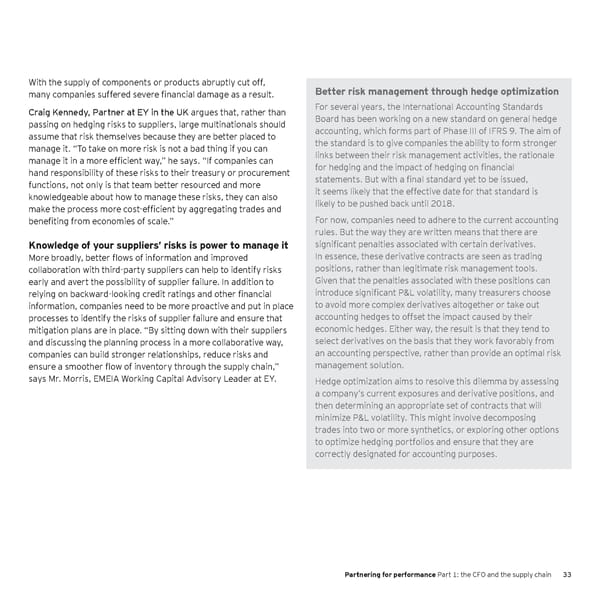With the supply of components or products abruptly cut off, many companies suffered severe financial damage as a result. Better risk management through hedge optimization Craig Kennedy, Partner at EY in the UK argues that, rather than For several years, the International Accounting Standards passing on hedging risks to suppliers, large multinationals should Board has been working on a new standard on general hedge assume that risk themselves because they are better placed to accounting, which forms part of Phase III of IFRS 9. The aim of manage it . “To take on more risk is not a bad thing if you can the standard is to give companies the ability to form stronger manage it in a more efficient way,” he says. “If companies can links between their risk management activities, the rationale hand responsibility of these risks to their treasury or procurement for hedging and the impact of hedging on financial functions, not only is that team better resourced and more statements. But with a final standard yet to be issued, knowledgeable about how to manage these risks, they can also it seems likely that the effective date for that standard is make the process more cost-efficient by aggregating trades and likely to be pushed back until 2018. benefiting from economies of scale.” For now, companies need to adhere to the current accounting rules . But the way they are written means that there are Knowledge of your suppliers’ risks is power to manage it significant penalties associated with certain derivatives. More broadly, better flows of information and improved In essence, these derivative contracts are seen as trading collaboration with third-party suppliers can help to identify risks positions, rather than legitimate risk management tools . early and avert the possibility of supplier failure . In addition to Given that the penalties associated with these positions can relying on backward-looking credit ratings and other financial introduce significant P&L volatility, many treasurers choose information, companies need to be more proactive and put in place to avoid more complex derivatives altogether or take out processes to identify the risks of supplier failure and ensure that accounting hedges to offset the impact caused by their mitigation plans are in place . “By sitting down with their suppliers economic hedges . Either way, the result is that they tend to and discussing the planning process in a more collaborative way, select derivatives on the basis that they work favorably from companies can build stronger relationships, reduce risks and an accounting perspective, rather than provide an optimal risk ensure a smoother flow of inventory through the supply chain,” management solution . says Mr . Morris, EMEIA Working Capital Advisory Leader at EY . Hedge optimization aims to resolve this dilemma by assessing a company’s current exposures and derivative positions, and then determining an appropriate set of contracts that will minimize P&L volatility . This might involve decomposing trades into two or more synthetics, or exploring other options to optimize hedging portfolios and ensure that they are correctly designated for accounting purposes . Partnering for performance Part 1: the CFO and the supply chain 33
 Partnering for Performance Part 1 Page 34 Page 36
Partnering for Performance Part 1 Page 34 Page 36